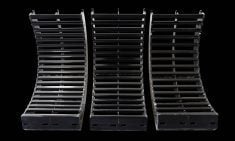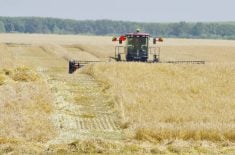When it’s all said and done, the past production season is going to feature a few success stories and a whole lot of hard-luck tales.

Manitoba’s 2021 crop and hay production will clearly be below average when all the data is compiled later this year, says Keystone Agricultural Producers’ (KAP) president Bill Campbell.
“Overall in the province if you look from a 10,000-foot level… it may not appear to be that terrible,” he said in an interview Oct. 20 following KAP’s online advisory council meeting.
“But I don’t doubt it will be less than average. But what is average and what is normal anymore? We’ve had some pretty good production years.
“Our understanding is there will be a significant amount of crop insurance claims.”
Farmers attending the meeting from across the province reported yields of almost nothing to above average in their districts.
Read Also

Local farm businesses, groups look forward to Manitoba Ag Days 2026
Most of agriculture is seemingly at Manitoba Ag Days each January: Manitoba agribusinesses and farm groups look forward to connecting with farmers at the 2026 show.
Why it matters: This will be a year many Manitoba farmers want to forget, but for some it will be among their best thanks to lucky rains, decent yields and record prices.
The provincial crop insurance agency agrees it’s likely to be a busy year.
“We’re still expecting it to be a pretty darn significant (payout) year from our perspective,” said David Van Deynze, chief product officer with the Manitoba Agricultural Services Corporation (MASC) in an interview Oct. 21.
Farmers have until Nov. 30 to submit crop insurance claims and their Harvest Production Reports, he said. Then MASC staff tabulate the yield data. Some of it is published in Yield Manitoba and on MASC’s website in February. He echoed Campbell’s assertion that production was anything but uniform this year.
“I honestly believe the variability will be more extreme than it has ever been,” Van Deynze said. “And when you go from five bushels an acre to 75 bushels an acre of wheat the averages aren’t probably going to be reflective of the drought. And if you’re in the drought the impact is going to be huge. There’s no doubt about it.”
It’s bad enough for the farmers who had poor yields, but with rising inputs, including nitrogen at more than $1 a pound, it’s going to add stress to many farmers, Andrew Melnychenko, who farms near Grandview, told the meeting.
“I would like to say these prices we are seeing are exciting, but something to keep in mind for everybody is the amount of risk with the price of fertilizer, the seed,” he said. “I think we’re going to see some guys struggling mentally where they didn’t have a great crop this year and they’re looking at some of the input prices for next year. I think we really need to be cognizant of that.”
Campbell agrees.
“The risk exposure next year possibly can be something we have never encountered before,” he said later. “What it takes to put a crop in next year is going to be significantly higher than this year.”
He said for farmers like himself who have been at it awhile, the numbers are “alarming.”
He also said the higher commodity prices could be a fleeting thing, which makes the significantly higher input prices even riskier.
“Will they be there next year? I think producers better have their eyes wide open as they go through their budget or cropping intentions. How do you protect yourself?” Campbell said.
Safety nets
That’s why KAP wants business risk management programs at the top of the list as the federal and provincial governments negotiate the new Canadian Agricultural Partnership that funds programs such as AgriStability, which KAP and other farm groups complain, doesn’t do enough to help farmers when their margins decline.
Asked how optimistic he is about getting better aid programs, Campbell replied: “The challenge will be no different than what we’ve had the previous year. Does the provincial government have the funding capabilities to match the federal government?”
Ottawa has offered to improve AgriStability but Prairie provincial governments, which contribute 40 per cent of the funds to the federal government’s 60, won’t sign on because of the higher bill.
Program funding has stagnated, according to Campbell.
Moreover, with farmers expected to reduce greenhouse gas emissions to help mitigate climate change, they face additional costs and/or reduced revenues due to policies such as the carbon tax.
Ottawa wants farmers to cut carbon emissions 30 per cent by 2030. Some farmers and Fertilizer Canada fear that could result in farmers having to cut nitrogen, resulting in lower yields and billions of dollars in lost farm revenue.
“The stroke of a pen by government leaders can have such an impact without understanding the consequences,” Campbell said, adding that the federal government has also said it wants Canada to export more food to bolster Canada’s economy.
“You can’t say one thing and then restrict the ability to fulfil the mandate,” Campbell said. “At $1 a pound we’re not misusing this (nitrogen) product. We are very careful, and yes there can be some enhancements and programs like the 4R nutrient management, but some of those components (slow-release nitrogen) are a 10 to 15 per cent increase in costs. How can you entice me to utilize the best fertilizer when there’s a financial impact to do just the same old thing that we’ve always been doing?”
Earlier in the meeting Minto farmer David Rourke, said the report Fertilizer Canada commissioned accounting and consulting firm MNP to do on cutting nitrogen, worries farmers.
“It looked like it was just a protectionist type of approach from Fertilizer Canada giving a worst-case, no option outlook that we’re all going to lose a whole bunch of money,” Rourke said.
MNP acknowledged its study assumed a straight cut in fertilizer use and therefore farmers’ yields and revenue would decline.
“They (MNP) weren’t looking at any innovation or any creativity or anything outside of what was good for Fertilizer Canada really,” he added.
The 4R nutrient management program can help farmers use fertilizer more efficiently so emissions fall but not yields, Rourke said.
In addition companies are working on new biological and chemical ways to produce lower-emission nitrogen, he said.
“It (study) was kind of scaremongering and we have to stay away from that and look at what we can do in the future and not keep looking in the past… but where we need to be going,” Rourke said.
















